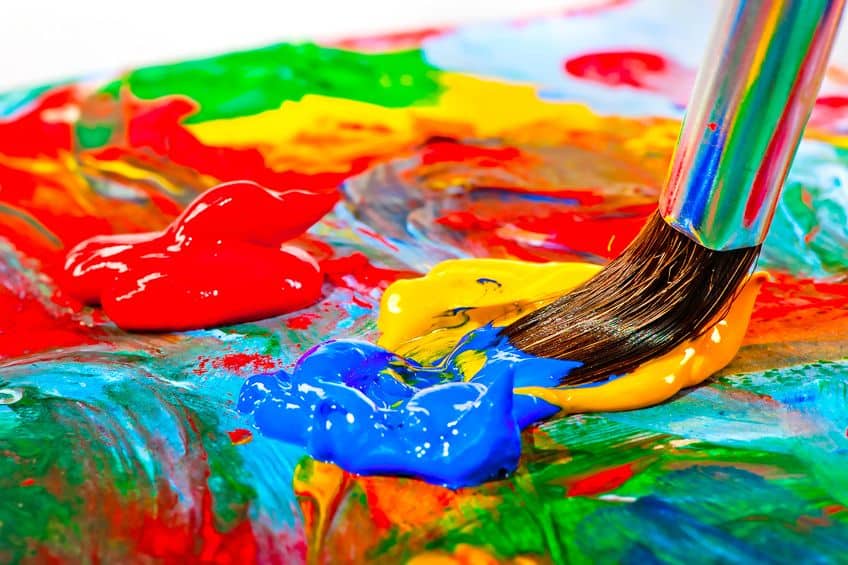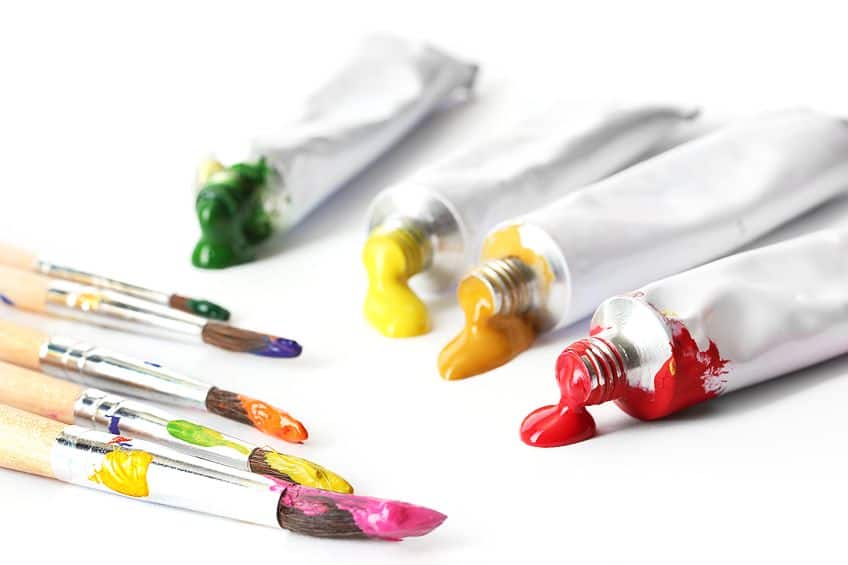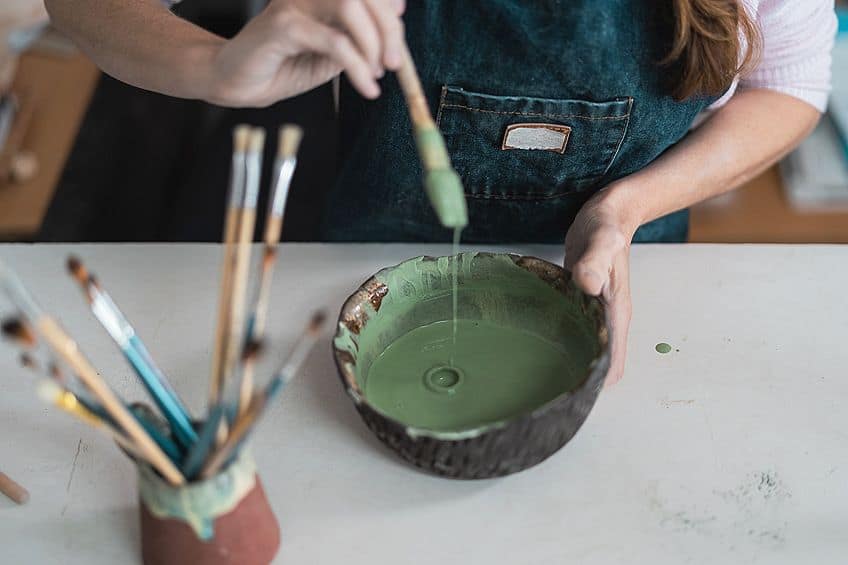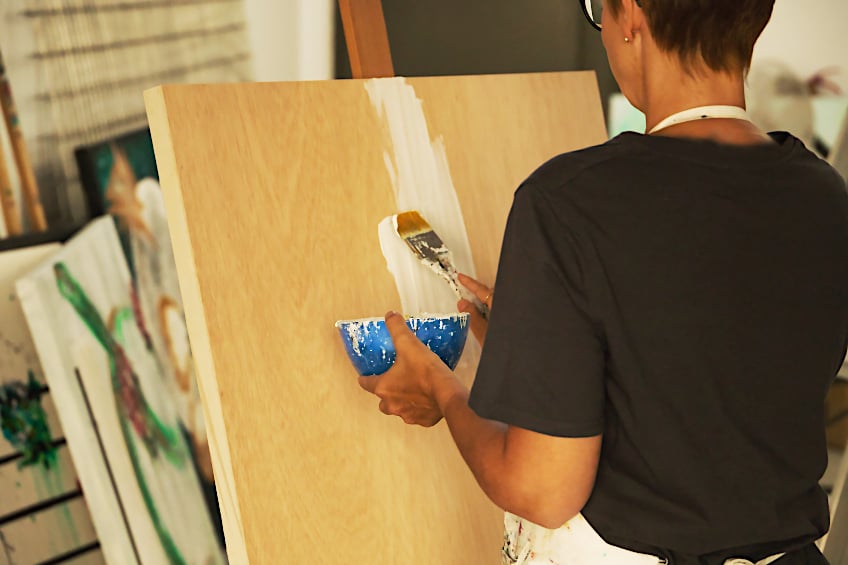What Is Acrylic Paint? – Find Out the Different Acrylic Paint Uses
Are you a rookie art-and-crafter with a burgeoning interest in working with paint mediums? Maybe you just want to learn more about acrylic paint in particular. Either way, you have come to the right spot! Acrylics are among the most popular kinds of paint in arts and crafts. In this article, we are going to cover all sorts of helpful and relevant information that should get you up to speed with all you need to know about acrylic paint.
Contents
What Is Acrylic Paint?
What is acrylic paint? What is acrylic paint used for? If these are questions that you need answers to, you have come to the right place. Here, you will not only learn about the many acrylic paint uses, but also about acrylic paint ingredients and even how to make acrylic paint yourself. Acrylic paint was invented in the 1940s. Although the first iterations of its kind were mineral spirit-based, most acrylic paints made today are water-based.
The key ingredient that makes acrylic paint unique is the acrylic polymer that is used as the binder.
When it comes to the best paints in the world of arts and crafts, one could easily argue that acrylic paints are the most popular. Beyond this, even, acrylic paints see extensive use throughout all forms of art involving paint, be it for fine, commercial, or decorative purposes. A big part of what can be attributed to the popularity of acrylic paints would be the fact that they are relatively affordable and available in nearly any color you could think of. Better yet, they are incredibly easy to find given that most craft stores and hardware retailers ought to stock them.
Water-based acrylic paints can sit on a shelf for up to 10 years so retailers will typically keep a healthy inventory. Acrylic paint is also universally praised within the art community at large for its relatively fast drying times. If you are working with thinner layers of acrylic paint, the painted surface should dry within less than 10 minutes. Thicker layers tend to take somewhere between 30 minutes to an hour to dry, which is nevertheless much quicker than other paints that can sometimes take days for layers to dry.
The acrylic polymer binding agent present in this type of paint also boasts a ton of flexibility, which allows the paint to retain a fair degree of elasticity.
This helps prevent flaking or the formation of cracks on the paint’s surface even when exposed to shifting temperatures. The acrylic polymer binder can expand and contract in response to warm and cold temperatures respectively, which greatly reduces the likelihood of environmental damage. For this reason, acrylic paint is used extensively for outdoor decor and clay painting.
Pros and Cons of Acrylic Paint
Acrylic paint is considered to be among the most multifarious painting mediums available to artists of this day and age. However, not everything that glitters is gold. There are indeed a few disadvantages to acrylic paints, which along with their benefits, we will discuss now.
PROS
- Acrylic paints are incredibly quick to dry, which increases the number of layers that can be added to a painting over a day.
- Being water-based, acrylics can be made soluble again and thus easy to wash off using nothing but soap and water.
- One of the biggest benefits of working with acrylic paints is their versatility and how well they adhere to most surfaces.
- You can slow down the rate at which acrylic paints dry using certain additives. As aforementioned, retarding mediums can be added to slow down drying times.
- Acrylic paints can be mixed with several other materials to produce special features and textures.
- Acrylic paints can withstand damage from shifting temperatures. The binding agent can expand and contract in response to alternating warm and cold weather, lessening the likelihood of flaking and chipping through prolonged exposure to the elements.
- After completely drying, acrylic paints develop a water-resistant surface. This protects the color vibrancy of the paint and safeguards the pigment from damage.
- Acrylic paints are non-toxic. This is good news for parents who want to paint with their toddlers.
CONS
- Since acrylic paints dry fast, you need to work even faster. Unlike oil paints, acrylic paints leave you with an incredibly short window in which to work until the paint begins to set.
- Acrylic paints are difficult to remove from certain surfaces. Removing acrylic paint from paintbrush bristles can be a hassle.
- Once dried, shades of acrylic paint can darken. If you are familiar with the colors produced by other paints such as oil paint, this might be quite noticeable.
- Acrylic paints are not considered as good as oil paints in fine art. This means that acrylic paintings are considered to have less prestige.
- Acrylic paints are yet to stand the test of time. We cannot yet say for certain that acrylic paints will retain their vibrancy over hundreds of years to the same capacity as, say, oil paints.
Acrylic Paint Ingredients
There are typically three primary acrylic paint ingredients; pigment, acrylic binder, and a vehicle. Microscopic units of pigment are mixed into an emulsion made of acrylic polymer binder, using water as the vehicle. That sounds very convoluted, so let’s break down the terminology:
Pigments
Pigments are the ingredients that give any paint its color. When isolated, pigments should look like powder. This is because pigments are composed of tiny granular particles that, when dispersed into a binder, help produce a liquid of the same color as the pigments. These solid granules of pigment will not dissolve in binding liquids, instead suspending themselves and producing a coloration of the mixture.
Another thing that makes pigments excellent for the purpose of giving a paint its color is the fact that the affinity between them and the surfaces to which they are applied is low if present at all.
Affinity, in this case, refers to the extent to which different particles can combine. The low affinity of pigments is what allows them to stay suspended in a binder without dissolving and also what prevents the color of a paint from dissolving into the surfaces to which they are applied.
Largely, most types of paints will use pigments to produce their colors.
When humans first started producing their own paint, pigments were created using crushed clay and other available minerals. Now that we have reached a time where we can produce synthetic materials that can serve the same purpose in paints, pigments can be made of either organic or inorganic materials.
Binders
Binders are liquid materials that are meant to prevent paint from lifting off of a surface once the vehicle, which in most cases is water, evaporates to leave a dry painted surface. In the case of acrylic paints, they get their name from the fact that acrylic binder is produced using artificial substances called acrylic polymers.
Once the water has evaporated, the acrylic polymer will form a dry layer above the pigment.
This functions as film protecting the paint from environmental damage and allows the color to adhere to the painted surface. The job of an acrylic binder is similar in concept to the process of laminating paper with plastic film.
Vehicles
In painting, the vehicle is a term we use to describe the viscous liquid meant to carry both the binder and pigment. For most of fine art’s history, oil has been and still is used for this purpose. Oil can function both as a binder and as a vehicle in many cases. In the case of acrylic paints, however, the most common vehicle is – as we have discussed – water.
When the polymer binder used in acrylic paints is mixed with water, the pair produces what we call a polymer emulsion.
After paint is applied to a surface, the water (AKA, the vehicle) will evaporate from the polymer emulsion, drying the paint’s surface and leaving behind a transparent layer of protective polymer film that keeps the pigment adhered to the surface while safeguarding it from environmental damage.
This is why experts who work with paint, whether it be in art or home décor, encourage you to stimulate airflow when you want the paint to dry faster as this expedites the evaporation of the vehicle.
More Acrylic Paint Ingredients
So far, we know that acrylic paints consist of three integral material components, these being pigments for the color, acrylic polymer for the binder, and water as the vehicle. However, these are not the only ingredients present in most commercially retailed acrylic paints. There are several different types of materials that are often added to acrylic paint mixtures to provide additive properties that improve effectiveness. Here are a few examples of such:
- Some acrylic paints contain buffers that modulate the alkalinity (pH) of the mixture. This can not only make the paint more durable against environmental exposure but can also speed up the drying time.
- Sometimes produced using peroxides or free radicals, initiators are typically added to mixtures of acrylic paint to stimulate polymerization. This means that it stimulates a quicker drying of the binder film of the polymer during and after the evaporation of the vehicle.
- Among the many additional ingredients that can be found in modern acrylic paints are surfactants, which act as a wetting agent that improves pigment dispersion while also moderating the acrylic polymers during the process of an aqueous emulsion. The surfactants most typically present in acrylic paints are produced using polyethylene oxides and other similar non-ionic materials.
- Artists can add defoamers to both paints and coats to neutralize and remove foaming bubbles from a mixture of paint before it is applied, thus preventing bubbles from forming on the painting surface that would otherwise damage the art. It is important to understand, though, that some defoamers can disrupt the coating process. This could lead to imperfections such as craters, trapped air pockets below the coat’s surface, popping, depressions, and fisheyes. Additional stabilizers can be added to the paint mixture to decrease the likelihood of these issues occurring.
- Stabilizers are an essential breakthrough in the contemporary sciences of paint. They are additive materials and chemicals that can be mixed into the paint to produce additional qualities to the paint that make it more effective for the job at hand. For instance, if you are painting a wall in a warm area that receives a lot of direct sunlight then you can mix UV-protective stabilizers into your paint to protect the wall’s surface. Stabilizers are also commonly used as a means to moderate the interactions between the pigment, binder, additives, and vehicle. The amount of effective acrylic paint uses increases when you adjust the mixture with stabilizers that make the paint more suitable for special jobs.
How to Paint with Acrylics
If you want to work with acrylic paint, the first step would of course be to learn how to use them. Not only will this make the process of painting with acrylics much easier, but it will also ensure the greatest possible aesthetic outcome for your piece.
Before we begin to discuss some of the various acrylic paint uses, we should provide some basic information and instructions that should assist you in understanding how to work with them, starting first with color suggestions. We will then move on to discussing what sort of tools you should use to paint with acrylic. Lastly, we are going to teach you how to seal your painting to preserve those vibrant colors and give it that professional finish.
Color Options
| Name | Hex Code | RGB | CMYK (%) | Color |
| Alizarin Crimson | #E32636 | 227, 38, 54 | 0, 83, 76, 11 | |
| Burnt Sienna | #EA7E5D | 234, 126, 93 | 0, 46, 60, 8 | |
| Cadmium Orange | #ED872D | 237, 135, 45 | 0, 43, 81, 7 | |
| Cadmium Red | #E30022 | 227, 0, 34 | 0, 100, 85, 11 | |
| Cadmium Yellow | #FFF600 | 255, 246, 0 | 0, 4, 100, 0 | |
| Dioxazine Purple | #800080 | 128, 0, 128 | 0, 100, 0, 50 | |
| Ivory Black | #000000 | 0, 0, 0 | 0, 0, 0, 100 | |
| Phthalo Blue | #000F89 | 0, 15, 137 | 100, 89, 0, 46 | |
| Phthalo Green | #123524 | 18, 53, 36 | 66, 0, 32, 79 | |
| Titanium White | #FFFFFF | 255, 255, 255 | 0, 0, 0, 0 |
You might be wondering to yourself, what is acrylic paint like in terms of its variety of color options? If so, you will be happy to know that acrylic paints come in hundreds of thousands of different shades. But, considering how wide your options are, it may prove difficult for a first-time painter to decide on what colors will work best. If such seems to be the case for you, here you will find some helpful information that should assist your efforts.
The first thing you may notice when shopping for acrylic paints is the varying prices between different colors and shades.
These cost differences may, in many cases, even be set independently of the grade of the paints themselves. This has to do with the fact that some pigments are easier to source and/or produce than others, and vice versa. By and large, you should expect to pay less for colors that fit on the earthy palette as these are often the most affordable.
On the other hand, acrylic paints containing cadmium pigments should be among the costliest options to choose from.
If this is your first rodeo with acrylic paints, we keenly suggest you do one of two things. Firstly, you could start by buying a pre-curated set of acrylic paints as this offers you a wide selection to choose from with the likely benefit of a bulk discount. Secondly, you could instead start by purchasing the 10 shades displayed in the table below. This is a selection of basic and (for the most part) affordable shades of acrylic paint that can be mixed in numerous combinations to create an even bigger palette of colors to paint with.
Tools for Acrylic Painting
Unlike oil painting, which requires a slew of different and often expensive accouterments, painting with acrylics requires relatively fewer tools to do the job. Better yet, the tools used for painting with acrylics are also much more affordable. If you plan on working with acrylic paint, you will need the following equipment:
- First and foremost, you will need to get some acrylic paint. As aforementioned, you should purchase either a pre-selected paint set or the ten colors in the list above.
- Make sure to get yourself a varied selection of paintbrushes. Try to avoid using brushes that use natural fibers as they tend to cause issues when working with acrylic paint. Instead, get yourself a brush with synthetic bristles. You should buy two flat brushes and two round brushes, with each pair having one large and one small option. As a beginner, these are your safest options.
- Set aside an old cup that you can fill with clean water to rinse the paint out of your brush when switching colors.
- Get yourself a surface that can be used to mix and test colors before applying them to your painting. This does not have to be an actual palette. You can, instead, use something functionally similar such as a plate or a sheet of cardboard. Just make sure that your palette surface is not hyper-absorbent.
- The best thing to mix your paints with is a palette knife. Make sure that you have one on hand so that you do not need to use your brushes for mixing. Brushes are designed to collect and transfer paint and thus risk clogging when used as a mixing tool. Furthermore, the resistance generated by the paint mixture when stirred with a brush can also cause damage to the bristles.
- Lastly, you are going to need a canvas. This does not need to be an actual canvas in the traditional sense, just any surface that acrylic paint can adhere to.
These tools are absolute essentials if you plan on working with acrylic paints. But once you have them, you will have at your disposal the key components necessary to work most effectively and efficiently with this medium. Better yet, all of these tools can be used several times before needing to be replaced. Yes, even the canvas can be reused.
Understanding Drying Times
If you have little to no prior experience with acrylic paint, you might be shocked to find out just how fast it can dry when applied to a surface, especially in comparison to most other popular forms of paint. But make sure that you pre-empt these faster drying times and adjust your workflow accordingly to not get caught off-guard.
Acrylic paints dry extremely fast and cannot be returned to a liquid form once it has hardened and moisture has evaporated.
To keep your stock of acrylic paints liquified and in a fit state for use the next time you need them, be sure to always properly close and secure the lids of jars and tubes when not in use. Make sure that your paints are sealed airtight as the exposure to the atmosphere will cause them to dry out. To extend the lifespan of stored acrylic paints even further, stash them somewhere cool and dry. To can even preserve the paint mixtures resting on your palette in between sessions by sealing them as airtight as possible using plastic wrap.
Besides storage, the most important thing to consider regarding the fast drying times of acrylic paints is how this affects an artist’s workflow. With faster drying times, artists who use acrylic paint can complete multiple layers over a day. The clear benefit here is, of course, a faster turnaround time. However, this comes with one major drawback; faster drying times may force artists to work faster. Under these time constraints, one’s focus may be stretched across the canvas too much so for their liking.
But such is the nature of acrylics, and it is something worth learning how to navigate should you wish to master the medium.
The good news is that there are additives that can be mixed into acrylic paint to slow down the rate at which it dries. Chemicals that we refer to as retarding mediums can be added to your paint to prevent it from losing its moisture and hardening too fast. If you are new to acrylic painting or would simply not like to be rushed while painting, you might want to consider investing in a retarding medium.
It will inhibit the vehicle’s ability to evaporate as quickly as would otherwise be expected, affording you a wider timeframe in which to nail the finer, more elaborate details in your artwork. If you are blending acrylics to make other colors, a retarding medium will also allow them to sit on your palette for much longer before drying out.
A Smooth Finish
Once you have completed your acrylic painting, you now have the option to add a final layer of varnish as a finishing touch. This last part is not necessarily crucial to the process of making beautiful art with acrylic paints, but it does help preserve the fruits of your efforts for longer. The acrylic polymer binder in this paint should already produce a relatively durable layer that will protect the paint from a moderate degree of environmental exposure. But, this thin layer of protection is by no means fit to stand the test of time.
If you want your acrylic paintings to retain their quality over longer periods, or if you want to protect their surfaces from external damage as much as possible, you should apply a coat of varnish once your paint has completely dried.
Better yet, varnishes tend to give paintings a more professional, sheeny finish. When working with acrylic paint, the best varnishes to work with are polymer resins, which are chemically similar in many ways. The polymer resins found in these varnishes are, much like acrylic paints, dissolved into an acrylic emulsion.
These varnishes pair excellently with acrylic paints and users can expect fast drying times. There are other varieties of varnish, such as those that are solvent-based, that will work with acrylic paints but their drying times tend to be significantly slower. Regardless of the type of varnish you use, however, you can always speed up the drying time by stimulating airflow around the painting as it dries. Just be sure to remove any loose materials such as dust and hairs from the painting before you varnish it.
As long as your painting is completely dry, it can even be wiped down using a slightly damp cloth before being varnished.
You can buy brushes designed specifically for the application of varnish to paint that you can purchase from most arts and crafts stores. Use these brushes to apply a thin coating layer to the surface of your painting. Unless completely necessary, you should wait for your varnish to completely dry before touching the surface of your painting again. Once the varnish has hardened enough to become tacky, you can lean your painting at an angle against a wall, facing inward. This is an easy way to reduce the chances of any foreign materials falling and sticking onto the varnished surface of your painting.
For beginners and experts alike, acrylic paints offer great versatility, reliability, and vibrancy. Congratulations on making it this far in the article. By now, you should know more than enough to answer the question, “what is acrylic paint effectively?” You should also know a little bit more about how to use acrylic paints and we hope that this assists you in your future artistic endeavors.
View our Acrylic Paint web story here.
Frequently Asked Questions
What Is Acrylic Paint Used For?
Acrylic paints are primarily used in fine art to create paintings and add color to pottery. Acrylics are also often used in home decor to color walls and furniture. Acrylic paints are a popular medium used in creating faux finishes on a wide variety of surfaces as well.
How to Make Acrylic Paint?
The instructions on how to make acrylic paint are fairly straightforward and creating your own can be very simple provided that you have the three main ingredients, pigment, binder, and water. Start by mixing your water and pigment in a 50/50 ratio and then grinding the mixture into an even paste, adding more water or pigment as you go depending on the consistency. Afterward, you can begin to slowly mix in your acrylic polymer binder until your mixture has the desired consistency and glossiness. And then, voilà! You have made your very own acrylic paint!
Megan is a writer and researcher who holds a degree in Social Sciences, with a specialization in Psychology and Environmental Science, from the University of Cape Town. Her dedication to acquiring knowledge and making a positive impact has driven her current work in promoting conscious and sustainable growth in Southern Africa. Megan’s interests encompass exploring the physical and psychological impacts of color in our environment on our mood and well-being. She is also passionate about the role of art and creativity, which has been an integral part of society since the beginning of human history. Since 2022, Megan has been contributing blog posts on painting and color theory at artfilemagazine.
Learn more about Megan van Schoor and about us.
Cite this Article
Megan, van Schoor, “What Is Acrylic Paint? – Find Out the Different Acrylic Paint Uses.” artfilemagazine – Your Online Art Source. December 24, 2022. URL: https://artfilemagazine.com/what-is-acrylic-paint/
van Schoor, M. (2022, 24 December). What Is Acrylic Paint? – Find Out the Different Acrylic Paint Uses. artfilemagazine – Your Online Art Source. https://artfilemagazine.com/what-is-acrylic-paint/
van Schoor, Megan. “What Is Acrylic Paint? – Find Out the Different Acrylic Paint Uses.” artfilemagazine – Your Online Art Source, December 24, 2022. https://artfilemagazine.com/what-is-acrylic-paint/.













